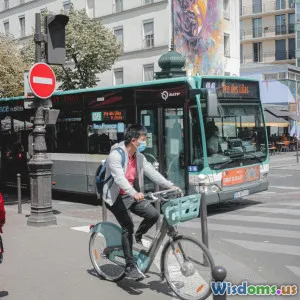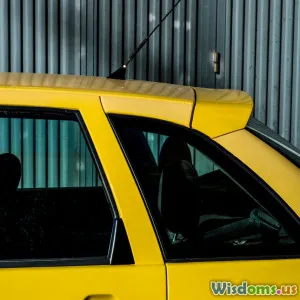
Urban Mobility Lessons From Paris Planners
14 min read Discover urban mobility strategies Paris planners used to create sustainable, people-centered cities. (0 Reviews)
Urban Mobility Lessons From Paris Planners
Picture cycling along the banks of the Seine, noticing pedestrians, electric scooters, and buses moving seamlessly across broad boulevards made famous by history. Few cities have pushed the boundaries of urban mobility like Paris, transforming its traffic-clogged avenues into vibrant spaces for people, life, and sustainable movement. As Paris demonstrates bold, coordinated action, its lessons prove invaluable for cities worldwide aspiring to reimagine their own streets.
The Parisian Approach to Urban Mobility

Paris provides a living laboratory for innovative mobility planning. In just over a decade, the French capital has reduced car dominance, unlocked vibrant public spaces, and prioritized sustainability. This didn't happen by chance—success hinged on a deliberate, multi-year vision championed by city planners and policymakers.
Anne Hidalgo, Paris's mayor since 2014, led the charge to create a “15-minute city,” where all essential services are accessible within a short walk or cycle ride. Her administration's priorities included:
- Reclaiming road space formerly dedicated to vehicles for pedestrian promenades and bike lanes
- Expanding eco-friendly public transport and last-mile connectivity
- Enforcing strict emissions regulations and incentivizing zero-emission vehicles
Example: The Champs-Élysées Restoration Once defined by bumper-to-bumper traffic, the Champs-Élysées is undergoing redevelopment to halve road space for cars while expanding tree cover and pedestrian areas. This flagship project demonstrates Paris's willingness to tackle high-profile, car-centric landscapes—and do so in consultation with residents and designers.
Lessons for global planners: A clear, strategic vision set and endorsed by leadership is fundamental. Urban redesign must be both top-down and embrace bottom-up community engagement.
Pedestrianization: Prioritizing People Over Cars

Paris planners treat sidewalks and public squares as living rooms for the city, not mere transit corridors. Expanding pedestrian zones became central to their strategy, altering urban rhythms—and quality of life.
During COVID-19, Paris accelerated the transformation of major roads, turning lanes and even entire streets into rues piétonnes (pedestrian roads). The initiative extended beyond temporary interventions:
- Rue de Rivoli, a historic east-west artery, became majority car-free and was repurposed for bikes, bus, and pedestrians after overwhelming advocacy.
- Parvis de l’Hôtel de Ville (City Hall Square) became an outdoor cultural hub, free of car traffic and dense with activity.
Concrete Results: Statistics from urban authorities show a 35% increase in walking in newly pedestrianized central Paris districts and a 20% decrease in air pollutants (NO2/PM2.5). Hospitality businesses—cafés, bistros, cinemas—report higher foot traffic and longer customer dwell times on shared streets.
Tips for Other Cities:
- Start with small-scale car-free pilots, then expand on success.
- Communicate changes early and involve shop owners and residents to avoid backlash.
- Use data to monitor outcomes—air quality, business revenues, and public satisfaction.
Cycling Revolution: Safe Infrastructure and Culture

Paris’s cycling transformation is one of Europe's most striking. The city added over 1,000 km of new cycling lanes between 2015 and 2023, earning praise from cycling advocacy groups and urbanists worldwide.
How Paris Did It:
- Built coronapistes—emergency bike lanes—for pandemic resilience, many of which became permanent.
- Connected neighborhoods with continuous, segregated cycling infrastructure, prioritizing safety and accessibility.
- Subsidized e-bike and cargo bike purchases, especially for delivery workers and families.
- Established dedicated, secure parking facilities for bikes (e.g., at train stations and interchanges), mitigating concerns about theft.
Comparison Example: As of late 2023, cycling as a commuting mode in Paris rivals cities like Amsterdam and Copenhagen. The daily cycling trips exceeded 1 million by late 2023—up from 370,000 a decade earlier.
Practical Insights:
- Cycling networks must be comprehensive—do not leave “last-mile” gaps.
- Infrastructure investments pay off when paired with education: Paris ran workshops for women and school children to foster cycling skills and confidence.
- Public messaging, such as "Paris Respire” (Paris breathes), raised the status of two-wheeled commuters.
Public Transit: Integration, Expansion, and Equity

The Parisian approach to public transit is rooted in integration and accessibility. With one of Europe’s densest and most well-connected metro networks, the Île-de-France region’s planners still saw room for improvement.
Key Moves:
- Grand Paris Express — A transformative €35 billion metro expansion, creating four new automated lines by 2030 and doubling the network’s length. This will connect suburbs, avoiding unnecessary trips through the congested city center.
- Unified Ticketing: The Navigo card enables seamless trips on metro, buses, suburban trains, and even shared bikes.
- Expanded Bus Services: Implementation of bus rapid transit (BRT) lanes, especially in underserved, outer arrondissements and banlieues (suburbs).
Actionable Takeaways:
- Equity-driven planning brings mobility options to peripheral neighborhoods, combating social exclusion.
- Convenient, accessible transit hubs (“Hubs de mobilité”) cluster connections to bikes, scooters, and taxis, making multi-modal trips effortless.
Tackling Car Dependence: Restrictions, Pricing, and Incentives

Reducing car use required more than new options. Paris planners implemented a mix of "carrot and stick":
- Low-Emission Zones (ZFE) ban older, polluting vehicles from most city neighborhoods during daytime. Violators face substantial fines, encouraging clean vehicle adoption.
- On-street parking reduction: Paris cut around 60,000 parking spaces—transforming them into pocket parks, playgrounds, and terrasses (open-air café seating).
- Congestion pricing: While still debated for the core, Paris ramped up pricing for curbside parking and maintained a tightly regulated taxi system to discourage car trips.
- Fleet Electrification: By 2024, over 40% of city buses are electric or hybrid; all taxis and ride-hailing vehicles must be zero-emissions by 2030.
Example: The ban on pre-2006 diesel cars within the ZFE covers 5.6 million people; by 2030, all gas and diesel vehicles will be banned.
Lessons Learned:
- Do not propose restrictions without first offering credible, affordable mobility alternatives.
- Transparent timelines ease public pushback and allow residents time to adapt.
Community Engagement and Participatory Planning

Paris’s most radical changes—whether expanding a bike lane or closing a main street to cars—succeeded thanks to deep, deliberate community involvement.
Participation Tactics:
- Repeated public consultations in affected quarters, allowing for genuine dialogue and co-creation.
- Participatory budgeting, which, over several years, funneled over €100 million to citizen-led mobility, greenery, and safety projects.
- Rapid-response surveys (online, at stations, and via text) to gauge commuter satisfaction and adapt plans as needed.
Concrete Cases:
- In the Boulevard de Bercy transformation, designers altered curb height and crosswalk placements based largely on feedback from older residents and those with disabilities.
- Children’s "School Streets" pilots, closing roads around schools at pick-up and drop-off, became permanent after overwhelmingly positive feedback from parents and teachers.
Advice: Always cement change through iterative, two-way communication. Demonstrate that city administration listens and is willing to tweak plans based on real-life experience and inclusion.
Green Mobility: Integrating Urban Greening With Transport

Paris redefined urban mobility as inseparable from environmental health. Parisian planners didn’t simply overlay bike lanes and bus stops onto a concrete city—they acted on the maxim: mobility and ecology must go hand-in-hand.
Transformations:
- La petite ceinture, a derelict 19th-century railway, became a continuous green corridor for walkers and cyclists, punctuated by native shrubs and community gardens.
- Tree-lined boulevards: The city aims to plant 170,000 trees by 2026, many shading major routes. Cooler microclimates make walking and cycling more attractive year-round.
- Micro-parks, rain gardens, and permeable paths are stitched into mobility upgrades, aiding stormwater management and air quality.
Proven Results: Urban heat island research reveals street temperatures drop 2-4°C under mature tree canopies, directly benefiting active commuters and bus-priority corridors.
Best Practices:
- Pair new transit investments or street redesign with ecological retrofitting—trees, pollinator beds, and pocket wetlands.
- Plan "greenways" that attract walkers and riders while improving biodiversity and climate resilience.
Lessons for Cities Worldwide: Adapting the Paris Model

No two cities are identical—but Paris demonstrates replicable principles for urban mobility transformation:
- Start with a Clear Vision: Political backing (from city hall to town meetings) and a comprehensive action plan are crucial.
- Tackle the Street, Not Just Infrastructure: Redesign major avenues, prioritize crossings, support pop-up culture, and foster a sense of place.
- Invest in Physical and Digital Mobility: Integrate shared mobility services into public transport apps with real-time updates.
- Communicate Every Step: Sustain public trust through relentless consultation and visible short-term wins.
- Commit for the Long Haul: Most Paris projects span a decade or more. Success takes patience and adaptability.
Considerations for Scaling Up
While the Paris example is ambitious and resource-intensive, even smaller or less-resourced cities can draw inspiration:
- Test pedestrian days on main squares: see if car-free weekends generate excitement.
- Repurpose a single block as a green plaza and document business and resident experiences.
- Pilot cycling corridors by marking painted lanes, then invest in protected alternatives upon success.
By mixing bold dreams with pragmatic steps, Paris teaches that humane, livable, and sustainable urban mobility truly is within reach. As global urbanization accelerates, cities have much to gain by borrowing from the Parisian playbook—adapting, refining, and, above all, acting on behalf of people and the planet.
Rate the Post
User Reviews
Popular Posts

















